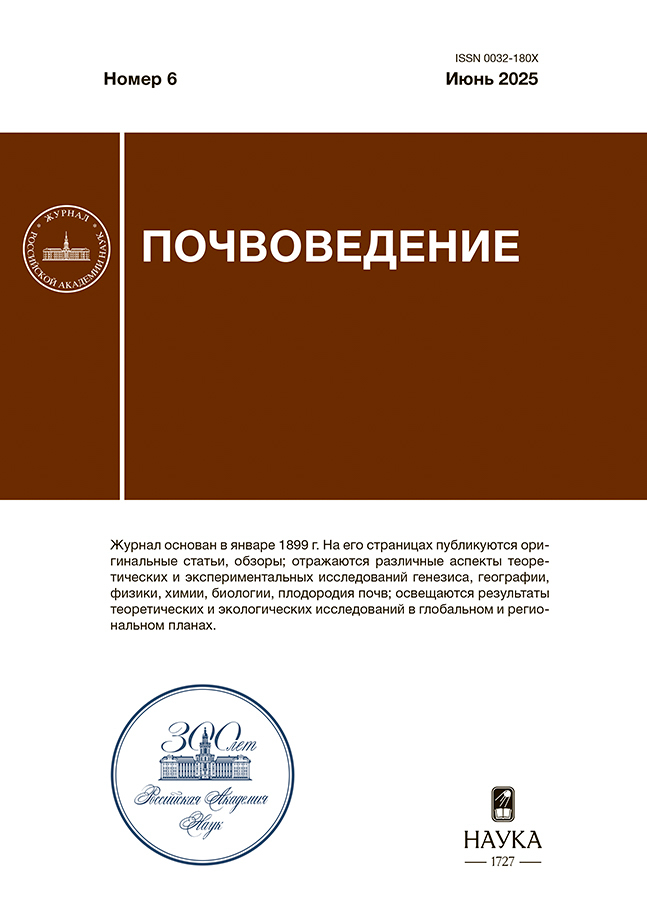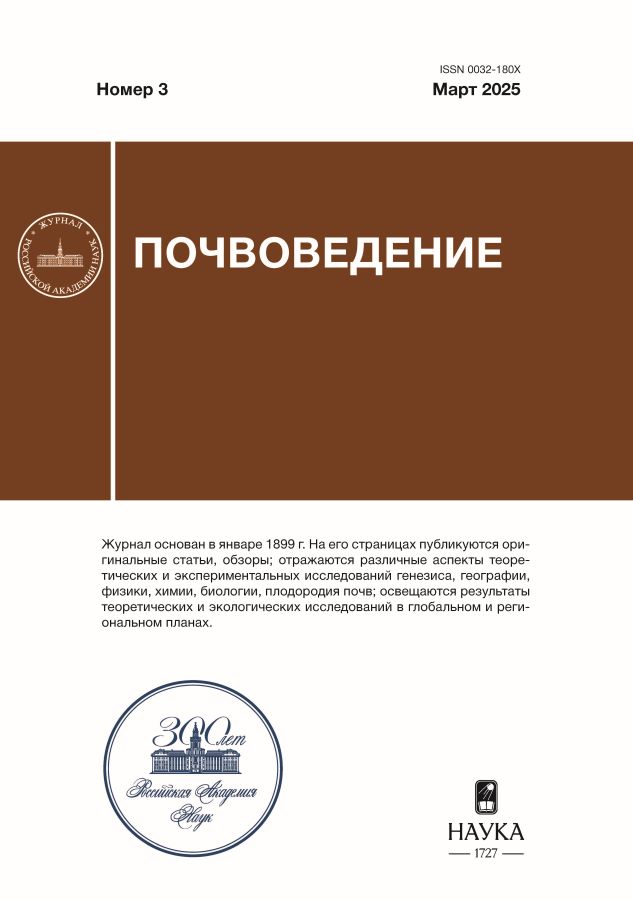Cryogenic Effect on the Formation of Permafrost-Affected Loamy Tundra Soils at Different Stages of Their Development
- Authors: Gubin S.V.1
-
Affiliations:
- Institute of Physico-Chemical and Biological Problems in Soil Science of the Russian Academy of Sciences
- Issue: No 3 (2025)
- Pages: 331-346
- Section: GENESIS AND GEOGRAPHY OF SOILS
- URL: https://freezetech.ru/0032-180X/article/view/683360
- DOI: https://doi.org/10.31857/S0032180X25030017
- EDN: https://elibrary.ru/CLOVGN
- ID: 683360
Cite item
Abstract
The morphology of soil profiles during their summer and winter period was studied as well as the microstructure and major physic chemical properties of permafrost-affected loamy tundra soils. Studied objects were the initial (zero-moment) soils and the same profiles after 7 and 23 years up to the fully developed soil profiles of Middle and Early Holocene age. The leading role of the cryogenic processes in formation of morphology and properties and structure organization at different stages of development was determined. This effect realizes through the thermal yield ability and ice segregation. The difference of summer and winter structural organization was obtained. The instability of morphological features formed by cryogenic processes was also determined. These features may change and disappear due to the changes in hydrothermal regime, freezing-thawing processes, ice segregation forms. The stability of soil structure is determined by the formation of soil-aggregate chemical complexes. It was also shown that the structural morphological features in soil diagnostic horizons form before the significant differences of chemical properties appear. The cryogenic effect on soil formation is mainly realized through the microturbations of the uppermost horizons at the initial stages of soil formation. Later on, the horizontal and vertical migration of organogenic material may affect the structure and properties of the middle and lowermost soil horizons. One of the leading processes in permafrost-affected soils’ formation is the physical (cryogenic) disintegration of plant litter and forming of detritus in the upper parts of the profiles and coarse humus enrichment of the middle and lowermost soil horizons due to the cryoturbation.
Keywords
Full Text
##article.viewOnOriginalSite##About the authors
S. V. Gubin
Institute of Physico-Chemical and Biological Problems in Soil Science of the Russian Academy of Sciences
Author for correspondence.
Email: gubin.stas@mail.ru
Russian Federation, 2, Institutskaya St., Pushchino, Moscow Region, 142290
References
- Аринушкина Е.В. Руководство по химическому анализу почв. М.: Изд-во Моск. ун-та, 1970. 487 с.
- Атлас сельского хозяйства Якутской АССР. М., 1989. 115 с.
- Губин С.В. Динамика формирования структуры тундровых мерзлотных неглеевых почв (тундровых криоземов) // Почвоведение. 1993. № 10. С. 62–70.
- Губин С.В. Почвообразование сартанского криохрона в западном секторе Берингии // Почвоведение. 1998. № 4. С. 278–280.
- Губин С.В., Занина О.Г. Новые подходы к оценке характера синлитогенного почвообразования позднего плейстоцена. Почвенные процессы и пространственно-временная организация почв. М.: Наука, 2006. С. 35–45.
- Губин С.В., Лупачев А.В. Почвы суглинистых водоразделов приморских тундр Севера Якутии: условия и процессы формирования // Почвоведение. 2017. № 2. С. 147–159.
- Губин С.В., Лупачев А.В. Роль пятнообразования в формировании и развитии криоземов приморских низменностей Севера Якутии // Почвоведение. 2017. № 11. С. 1283–1295.
- Губин С.В., Лупачев А.В. Почвы и отложения озерно-аласных котловин тундр Колымской низменности // Почвоведение. 2020. № 7. С. 775–790.
- Еловская Л.Г., Петрова Е.И., Тетерина Л.В. Почвы Северной Якутии. Новосибирск: Наука, 1979. 453 с.
- Еловская Л.Г., Тетерина Л.В. Почвы приколымской тундры. Растительность и почвы субарктической тундры. Новосибирск: Наука, 1980. C. 158–195.
- Ершов Э.Д. Влагоперенос и криогенные текстуры в дисперсных породах. Изд-во Моск. ун-та, 1979. 214 с.
- Ершов Э.Д., Лебеденко Ю.В., Петров В.С. Методика количественной оценки величин пучения оттаивающих влагонасыщенных грунтов. Мерзлотные исследования. М.: Изд-во Моск. ун-та, 1980. С. 59–66.
- Жесткова Т.Н., Заболотская М.Н., Рогов В.В. Криогенное строение мерзлых пород. М.: Изд-во Моск. ун-та, 1980. 135 с.
- Жесткова Т.Н., Шур Ю.Л. Промерзание грунтов в условиях открытой системы // Мерзлотные исследования. 1980. Вып. 19. С. 164–177.
- Караваева Н.А. Тундровые почвы Северной Якутии. М., 1969. 205 с.
- Классификация и диагностика почв России. Смоленск: Ойкумена, 2004. 342 с.
- Коноровский А.К. Влияние промерзания на некоторые свойства мерзлотных почв // Почвенный криогенез и мелиорация мерзлотных и холодных почв. М., 1975. С. 198–201.
- Лупачев А.В., Губин С.В. Органогенные надмерзлотные горизонты криоземов // Почвоведение. 2012. № 1. С. 57–68.
- Пармузина О.Ю. Криогенное строение и некоторые особенности льдовыделения в сезонноталом слое // Проблемы криолитологии. М. 1978. Вып. 7. С. 144–164.
- Попов А.И. Розенбаум Г.Э., Тумель Н.В. Криолитология. М.: Изд-во Моск. ун-та, 1985. 239 с.
- Рогов В.В. Структурные связи в мерзлых грунтах // Криогенные процессы. М.: Изд-во Моск. ун-та, 1987. С. 93–101.
- Рогов В.В. Основы криогенеза. Новосибирск: ГЕО, 2009. 209 с.
- Романовский Н.Н. Основы криогенеза литосферы. М.: Изд-во Моск. ун-та, 1993. 335 с.
- Теория и практика химического анализа почв. М.: ГЕОC, 2006. 399 с.
- Теория и методы физики почв. М.: Гриф и Ко, 2007. 616 с.
- Чистотинов Л.В. Миграция влаги в промерзающих неводонасыщенных грунтах. М.: Наука, 1973. 118 с.
- Чувилин В.М. Формирование микростроения мерзлых пород. Автореф. дис. … канд. геол.-мин. наук. М., 1984. 12 с.
- Шарапова Т.А. Динамика криогенного строения пятен-медальонов. // Криогенные процессы. М.: Изд-во Моск. ун-та 1987. С. 153–158.
- Шеин Е.В., Милановский Е.Ю. Роль и значение органического вещества в образовании и устойчивости почвенных агрегатов // Почвоведение. 2003. № 1. С. 53–61.
- Gubin S. Role of cryogenic processes in the organization soil at macro- levels // Dokuchaev Soil Bulletin. 2016. V. 86. P. 53–63.
- Mackay J.R. and Mackay D.K. Cryostatic pressures in nonsorted circles (mud hummocks) Inuvik, North West Territories. Canad. // J. Earth Sci. 1976. V. 13. № 7.
- Van Vliet-Lanoe B. Frost effect in soils // Soils and Quaternary Landscape Evolution. London: Wiley, 1985. P. 117–158.
- Van Vliet-Lanoe B. The significance of cryoturbation phenomena in environmental reconstruction // J. Quat. Sci. 1988. № 3. Р. 85–96.
- Van Vliet-Lanoe B., Fox C.A., Gubin S.V. Micromorphology of Cryosols // Cryosol Permafrost – Affected Soils. Berlin: Springer, 2004. P. 365–390.
Supplementary files













